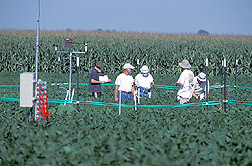This page has been archived and is being provided for reference purposes only. The page is no longer being updated, and therefore, links on the page may be invalid.
New Crop-Yield Study Casts Doubt on a Climate-Change Prediction
By Jan SuszkiwJune 30, 2006
Leading crop-production models predict that higher temperatures and dryer soils will diminish crop yields as a result of global climate change in the year 2050. The models also predict that another anticipated climate-change phenomenon—the yield-stimulating effects of elevated carbon dioxide—will offset those losses. So nothing gained or lost, right? Not quite, says a team of Agricultural Research Service (ARS), University of Illinois at Urbana-Champaign (UIUC), and Swiss scientists.
In this week's issue of Science, the researchers contend that today's simulation models overestimate the "CO2 fertilization effect," which refers to the improved efficiency of some crops in using sunlight to convert CO2 into sugars. The problem is, the models rely on data from enclosure studies, say ARS plant physiologists Donald Ort and Elizabeth Ainsworth, UIUC scientists Stephen Long and Andrew Leakey, and Josef Nösberger of the Institute of Plant Science in Switzerland. According to their Science paper, trapped heat, poor airflow, high humidity and other conditions inside greenhouses and growth chambers skew plant responses to elevated CO2.
To avoid these problems, the researchers used free-air concentration enrichment (FACE) to simulate the atmosphere of 2050 under actual field conditions. The method continuously exposes crop plants within 66-foot-diameter plots to 550 parts/million (ppm)—the CO2 concentration predicted for 2050. The current level is 380 ppm. Ort, who leads the ARS Photosynthesis Research Unit in Urbana, monitored the growth and yield of corn and soybeans there with his ARS and UIUC colleagues. In Maricopa, Ariz., an ARS collaborator monitored wheat and sorghum; in Switzerland, Nösberger examined forage grasses.
After collecting FACE data for the crops, the scientists compared it to earlier growth-chamber-based simulations. The difference was dramatic: CO2 fertilization-effect yield increases measured in the FACE experiments were 50 percent lower than the chamber simulations.
According to Ort, the finding warrants a reexamination of CO2's role in forecasting future yields, especially in the presence of other climate-change concerns such as ozone pollution, which is toxic to crops.
ARS is the U.S. Department of Agriculture's chief scientific research agency.

